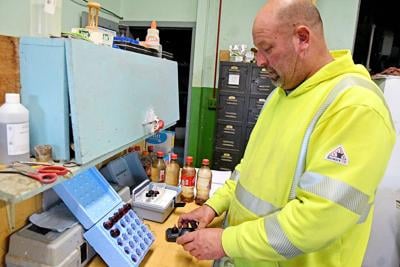
Chris Erdman, Paullina’s water and sewer superintendent, checks the fluoride level in a sample from the town’s drinking water supply using a colorimeter. The city of Paullina’s fluoride level is usually kept at .8-.9 milligrams per liter.
PAULLINA—The Centers for Disease Control and Prevention recently recognized the city of Paullina’s drinking water supply for its flourishing fluoride levels.
The O’Brien County community of about 980 was one of 107 cities in Iowa the CDC honored with the Water Fluoridation Quality Award, according to the Iowa Department of Public Health.
The award was given to cities that consistently maintained the mineral in their drinking water supply at a level that helps prevent tooth decay. The U.S. Department of Health and Human Services recommends a fluoride level of about .7 milligrams per liter.
Chris Erdman, Paullina’s water and sewer superintendent, said that is the minimum level of fluoride that is typically in the town’s drinking water supply.
“We’re usually right around a .8 to .9,” Erdman said.
He tests the fluoride level of Paullina’s drinking water supply daily using a colorimeter, which gives a reading on the amount of fluoride in a water sample.
Fluoride strengthens teeth by replenishing minerals on enamel that get eaten away by bacteria when people consume sugary foods and drinks.
Community water fluoridation has been used in the United States for more than 70 years as a safe and cost-effective way to prevent cavities.
While other products with fluoride — such as toothpaste and mouth rinses — aid in strengthening teeth, fluoridated water has been found to reduce cavities at a rate of 25 percent, according to the CDC.
A nationwide study from 2016 found community water fluoridation programs have saved an estimated $6.5 billion a year in dental treatment costs. In communities with fluoridation programs, individuals save $32 on average on dental care.
Although the federal government recommends community water fluoridation, cities are not required to fluoridate their drinking water supplies. That means cities may maintain their own fluoride levels while taking into account federal recommendations.
The recommended fluoride levels for community fluoridation programs are set high enough to effectively combat tooth decay yet low enough to avoid harmful effects such as fluorosis.
Fluorosis occurs when teeth are exposed to excessive amounts of fluoride over a long period of time and is marked by discoloration of tooth enamel.
*Original article online at https://www.nwestiowa.com/news/paullina-honored-for-water-quality/article_c441412a-1858-11ea-8b49-6bcf472fef58.html
